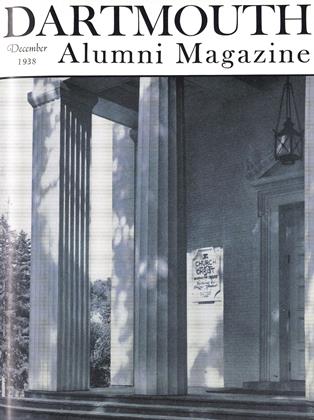MEMBER OF BOTANY STAFF DESCRIBES NEW METHODS OF DEPARTMENT
TEACHERS OF the introductory course in Botany in many institutions are beginning to recognize that a problem exists in connection with the organization of the laboratory work. While it is universally held that laboratory work is essential for effective teaching in such courses, there has been no general scrutiny and evaluation of the place of the laboratory in contributing to the goals of general education. There has been too much tendency to assume that the laboratory illustrates the scientific method and that the possession of a microscope makes the student an intelligent observer. Students have been required to keep a notebook in which they have recorded their observations by means of laborious drawings, the assumption being that by this method skills in observation, drawing, and dissection are inculcated which will be transferable, that if a student can make a good drawing he has achieved the ability to use the scientific method. These assumptions . are undoubtedly questionable. Generally speaking the student in the stereotyped course probably spends his time in making drawings with the objective of making a good drawing in order to secure a good grade; the work thus becomes mechanical and contributes little to the learning process.
PREPARED DRAWINGS SUPPLIED
In connection with the introductory Botany course at Dartmouth, these difficulties have long been recognized, and attempts to solve them have been made. A certain number of prepared drawings have been supplied to the student, to be labeled after a study of plant material. It has also been recognized that laboratory work cannot be graded objectively; the work has merely been graded Pass or Fail, in recognition of the fact that a letter grade fails to indicate the thoughtfulness, alertness, or industry with which the work has been done, or the knowledge which has been gained.
Continued efforts toward making the laboratory work more valuable to the student are being made at the present time. It is planned that eventually all or nearly all drawings will be supplied. In some cases these drawings are to be labeled by the student; in all cases careful comparisons must be made with available materials. Accompanying these prepared drawings are critical and thought-provoking questions, the answers to which must be given during the period; in addition directions are given to classify and tabulate observations. In the framing of these questions the attempt is being made to develop in the student the ability to draw sound inferences or conclusions from available data, the acquiring of information through the personal examination of materials in contrast to dependence upon information supplied, the ability to interpret new data and the ability to apply principles in the solution of new problems—all of these being aspects of the ability to use the scientific method. The attitude of the instructing staff during the laboratory period will as far as possible conform to the Socratic method; to ask questions which will enable the student to arrive at his own conclusions rather than to supply information.
EFFORT TO ELIMINATE DRUDGERY
It is recognized that this constitutes no radical change in teaching method. The Socratic method is, and always has been, used by good teachers everywhere in any subject. Undoubtedly it is practiced extensively in most courses in Dartmouth. In this case the change represents an effort to apply the method more effectively to the laboratory in an attempt to free the student from mechanical, interest-killing drudgery in order to give him more time for observing, thinking and learning.
This newer laboratory procedure is still incomplete and experimental, with many rough spots which need smoothing, but experience so far suggests that here is one of several roads to salvation in making effective the laboratory work in introductory Botany. There are no doubt other roads, perhaps better ones than have yet been tried.
Ross MCKENNEY HEAD MAN, AND R. H. GODDARD 'SO, CHAIRMAN OF D. O. C. RAVINE CAMP BUILDING COMMITTEE, TALK OVER CONSTRUCTION PROBLEMS IN DOORWAY, FRAMED BY HUGE LOGS, OF THE MAIN HOUSE. (Right) BUNKHOUSE AT MOOSILAUKE IS COMPLETED. IT WILL SLEEP 32 IN FOUR ROOMS FOR SIX PERSONS EACH, AND TWO ROOMS FOR FOUR.
 View Full Issue
View Full Issue
More From This Issue
-
 Sports
SportsFootball Review
December 1938 By BILL CUNNINGHAM '19 -
 Class Notes
Class Notes1929*
December 1938 By F. WILLIAM ANDRES -
 Class Notes
Class Notes1918*
December 1938 By ERNEST H. EARLEY -
 Article
ArticleProposed Mew Webster Hall
December 1938 -
 Article
ArticlePublications Decision by Trustees
December 1938 -
 Class Notes
Class Notes1912*
December 1938 By CONRAD E. SNOW








